Description
Honeydew Green Flesh Melon (A.K.A. Honeydew, Green-Fleshed Honeydew, White Antibes Winter, Winter Melon)
25 Seeds per pack
Days to Maturity: 100–115 Days
Sun Requirements: Full Sun
Botanical Name: (Cucumis melo)
Best Seller!
Brought to the U.S. around 1911 after years of cultivation in France and Algeria, this classic honeydew melon quickly became a treasured variety for its sweet, fragrant flesh and excellent keeping qualities. Known in Europe as ‘White Antibes Winter’ and in China as ‘Bailan’ or ‘Wallace’ melon, it remains a favorite for summer gardens!
Vines grow 12–18″ tall and sprawl up to 6–8′, producing smooth, creamy-white melons weighing 3–6 lbs. each. Fruits reach 7–9″ in length and 5–6″ in diameter, with firm, lime-green flesh brimming with sweet, honeyed flavor and subtle notes of apple and cucumber. The high sugar content of this melon makes it one of the sweetest melons around. Best grown in full sun and warm, dry conditions, it performs well in gardens, containers, raised beds, or greenhouses. Best suited to the South or Southwest, but with some TLC and southern exposure can be grown elsewhere. Ready to pick when the rind turns golden and emits a fragrant scent.
Packed with vitamins A, C, and K, along with folate, Honeydew Green Flesh is well worth growing in your garden!
Planting Instructions for Honeydew Green Flesh Cantaloupe Seeds
When to Plant:
Direct sow Honeydew Green Flesh Melon seeds outdoors 1 to 2 weeks after your last frost date, once the soil consistently reaches 70°F (21°C) or warmer. For shorter seasons or cooler regions, start seeds indoors 4 to 6 weeks before last frost, using peat pots or soil blocks to avoid root disturbance. Transplant outdoors after hardening off and when both soil and air temperatures are consistently warm and the danger of frost is past.
Where to Plant:
Choose a site in full sun that receives at least 8 hours of direct sunlight daily. Honeydew Green Flesh Melons thrive in fertile, well-drained soil with a pH of 6.0–7.0. Raised beds or south-facing slopes are ideal. Incorporate 2–3 inches of compost before planting. Avoid planting in areas that recently grew other melons, cucumbers, squash, or pumpkins.
How to Sow:
Sow seeds ½” to 1″ deep. If planting in rows, space seeds or transplants 18–36″ apart in rows 5–6′ apart. For hills, sow 3–4 seeds per hill and thin to the strongest 1–2 plants. For trellising, space plants 12–18″ apart along a sturdy support.
Watering:
Keep soil consistently moist through germination. Once vines are established, provide 1–2 inches of water per week. Water deeply and less frequently to encourage deep rooting. Reduce watering slightly once fruit begins to ripen to improve sweetness and avoid splitting. Avoid overhead watering to reduce the risk of mildew.
Fertilization:
Mix compost into the planting site before sowing. Additional fertilizer is typically not needed unless soil is poor. If desired, side-dress with compost tea, fish emulsion, or a balanced organic fertilizer once vines begin to spread and again when the first small fruits begin to form.
Mulching:
Once your seedlings are growing well, add mulch around the plants. Use black plastic if your goal is to warm the soil. Warmer soil helps seeds sprout faster and encourages early root and vine growth, which is especially helpful in cooler climates or early in the season. If you’re mainly trying to hold in moisture and stop weeds, straw or shredded leaves are good options, but they won’t help the soil warm up as much. Mulching also keeps the fruits clean by lifting them off the dirt and helps stop mud from splashing onto them when it rains.
Training & Pruning:
Vines can be allowed to sprawl or trained vertically. For vertical growth, support fruit with cloth slings. If desired, lightly prune some of the small side branches that grow off the main vine to help air move through the plant and let it focus energy on growing better-quality fruits. Avoid over-pruning, which can reduce flower production and sugar development.
Pollination:
Honeydew Green Flesh Melons produce both male and female flowers. Bees and other pollinators are essential for fruit set. Encourage pollination by planting pollinator-friendly flowers and herbs nearby. Good choices include borage, dill, sunflowers, marigolds, and oregano allowed to flower. These help attract bees and other insects that will visit your Honeydew Green Flesh Melon blooms. In low-pollinator areas, hand pollinate by transferring pollen from male to female blooms using a small paintbrush.
Common Pests & Diseases:
- Pests: Watch for aphids, cucumber beetles (vector for bacterial wilt), squash bugs, and vine borers. Use row covers until flowering, hand-pick pests, or apply insecticidal soap in the early morning or evening.
- Diseases: Powdery mildew, downy mildew, and leaf blights can occur. Improve air circulation, avoid overhead watering, and space plants adequately. Treat outbreaks with organic fungicides or DIY sprays (e.g., baking soda solution).
Harvesting:
Honeydew Green Flesh Melons are ready to harvest when the rind turns creamy white and the blossom end gives slightly under gentle pressure. A sweet, fragrant aroma will develop near the blossom end, and the skin may develop a slightly waxy feel. Unlike netted cantaloupes, Honeydew melons do not slip from the vine when ripe—cut them carefully when these signs appear.
Storage:
Store ripe Honeydew Green Flesh Melons at room temperature for a few days to finish ripening, or in the refrigerator for up to 2 weeks. Once cut, wrap the melon in plastic and refrigerate. Use within 3 days. Wash thoroughly before slicing to avoid transferring bacteria from the rind to the flesh.
Seed Saving:
Saving Honeydew Green Flesh Melon seeds is an enjoyable and economical way to preserve this classic heirloom variety. Honeydew Green Flesh Melons are insect-pollinated and cross readily with other melon types, so avoid growing multiple melon varieties within ½ mile of one another.
Let the melons ripen fully on the vine. Once picked, cut them open the long way and scoop out the seeds into a jar. Add room temperature (not hot) water and let the mixture sit for 2 to 4 days, stirring it once each day to help the seeds separate. Good seeds will sink, while pulp and non-viable seeds float. Pour off the debris, rinse the good seeds thoroughly, and spread them out on a paper towel or mesh screen to dry for several days in a well-ventilated area.
Once your seeds are fully dry, you can store them in a labeled container. For longer storage, you can keep the container right in the freezer. Freezing helps protect seeds from moisture, pests, and temperature swings, especially over many months. For a quick and easy option, use our seed-saving envelopes. They’re simple to use, pre-labeled, and include spaces to write the variety, date, and any notes you want to remember. They help keep your seeds neat, labeled, and easy to find when you’re ready to plant next season. When stored properly, Honeydew Green Flesh Melon seeds can last 3–5 years.
FAQ:
What is the historical or notable background of Honeydew Green Flesh Melon?
Honeydew Green Flesh Melon was introduced to the U.S. around 1911 after extensive cultivation in France and Algeria. Known in Europe as ‘White Antibes Winter’ and in China as ‘Bailan’ or ‘Wallace’ melon, this variety quickly became a garden favorite for its sweet, fragrant flesh and impressive storage capability.
How would you describe the flavor of Honeydew Green Flesh Melon?
This melon is celebrated for its firm, lime-green flesh that’s sweet, honeyed, with notes of apple and cucumber—making it one of the most flavorful and sugary melons you can grow.
What does Honeydew Green Flesh Melon look like, and what are its growing habits?
The plant produces smooth, creamy-white fruits weighing 3–6 lbs., reaching 7–9″ long and 5–6″ in diameter. Vines grow 12–18″ tall and spread 6–8′, thriving in warm, sunny locations with well-drained soil.
How and when do I harvest Honeydew Green Flesh Melon?
Harvest when the rind turns creamy white, the blossom end yields slightly to pressure, and a fragrant aroma develops. Unlike cantaloupes, they won’t slip from the vine—so look for these ripeness cues and cut the melons carefully.
When is the best time to plant Honeydew Green Flesh Melon?
Direct sow 1–2 weeks after the last frost when soil temperatures reach 70°F or warmer. In cooler climates, start indoors 4–6 weeks earlier and transplant once weather is reliably warm and frost-free.
What are the common culinary uses for Honeydew Green Flesh Melon?
This melon is a summer staple—perfect for fresh fruit salads, chilled soups, smoothies, and desserts. Its naturally sweet flavor also pairs well with salty or spicy accompaniments like prosciutto.
What’s the best way to store Honeydew Green Flesh Melon after harvest?
A whole, ripe Honeydew Green Flesh Melon can be kept at room temperature for a few days to continue ripening, or stored in the refrigerator for up to 2 weeks—longer than most melons. Once cut, wrap the pieces in plastic or store in an airtight container in the fridge and use within 3 days. Be sure to wash the rind thoroughly before slicing to avoid transferring bacteria to the flesh.
What nutrients does Honeydew Green Flesh Melon provide?
Packed with vitamins A, C, and K, plus folate, this melon supports immune health, skin, vision, and blood clotting—all while offering a deliciously refreshing snack.
Does Honeydew Green Flesh Melon have any notable disease or pest resistance?
While not inherently disease-resistant, it thrives with good air circulation and proper spacing. Common issues like mildew and aphids can be managed with organic methods and preventative care, such as mulching and pollinator planting.
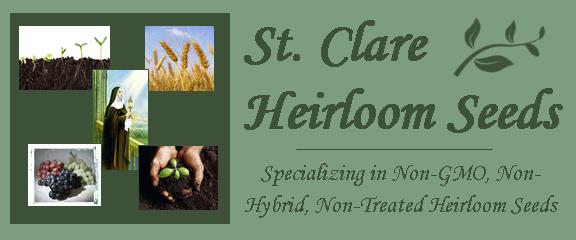
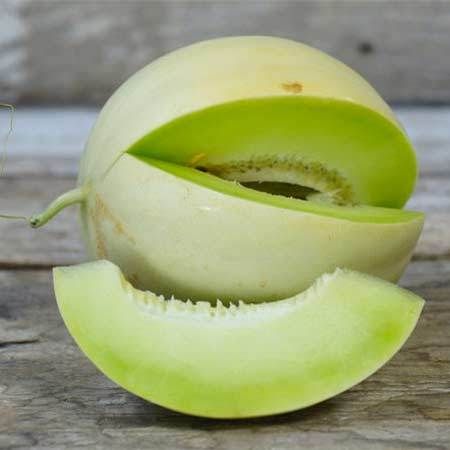




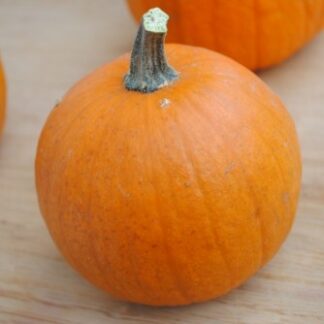





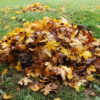
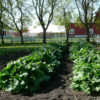

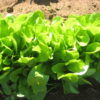

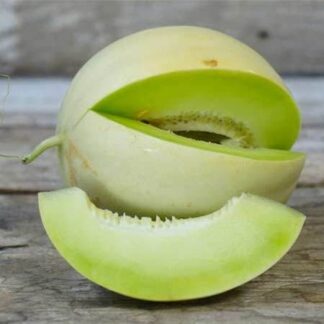

Becky (verified owner) –
All seeds I planted have sprouted! Looking forward to trying the melon in the summer.
Darrell cochran (verified owner) –
Can’t wait to try!
Melissa C. (verified owner) –
Can’t wait to plant more!
Sandra (verified owner) –
amazing
Rob M. (verified owner) –
Did very well here in the Southern Piedmont region!
Barbara McClure (verified owner) –
Debra Ann Boling (verified owner) –
5 star!